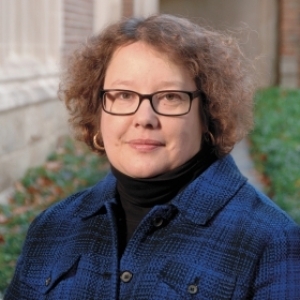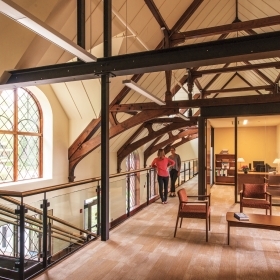Susan Challenger ’76 enjoys the walk to her office in Green Hall. “A favorite part of Wellesley is walking across the Academic Quad hearing the carillon,” she says. “I love that the alumnae office is where it is, so I can hear it all the time, whenever it gets played.”
After a career in high tech, Challenger returned to the notes of the carillon and the College as executive director of the Wellesley Alumnae Association in January 2008. She steps down from her position in January. She says she will miss the place and the people. “Wellesley is as vibrant today as it was for me as a student. I never ceased to be amazed at the dedication of the faculty and staff,” she says.
As she delved into her work at her alma mater, Challenger saw a need for connecting with alumnae in new ways, particularily during their nonreunion years. She had read the book Bowling Alone: The Collapse and Revival of American Community, by Robert D. Putnam, which concerns “meeting your constituents where they are,” and she knew that Yale had been developing interest groups among alumni. She thought that kind of structure could work well for Wellesley. “We had interest from the African-American alumnae, so we worked with [that group] first and it became a model,” she says.
Shared interest groups, affectionately known as “SIGs,” began to form, and now number more than a dozen. “The groups have different levels of engagement,” says Challenger. “Some have events. Some have a constitution, or bylaws. Some are discussion groups. They can be whatever the alumnae need them to be, and we provide support.”
SIGs are just one of many activities Challenger has overseen—from reunion to technology supporting alumnae groups around the globe. “The WCAA office and the executive director are the center of the web of connections among alumnae and the College,” says Laura Daignault Gates ’72, chair of the Board of Trustees, who was WCAA president when Challenger came on board. “Susan has juggled needs, expectations, and constraints like a magician, and that’s what it takes. She is a master of complex organizations.”
What is it that makes Wellesley alumnae so passionate about their connection with the College? “The water!” Challenger laughs. But in a more serious vein, she cites qualities that link alumnae, including the evocative beauty of the College, the connection with faculty, and the lifelong friendships that are made.
“Everybody remembers the lampposts and the steps that are worn from other people’s feet—the people who walked here before you,” she says. “And most alums will tell you that there were one or two faculty members who changed their lives. There’s also something all alumnae benefit from that I call the ‘Wellesley halo.’ By that, I mean that 90 percent of what people are going to think of you [as a Wellesley alum] when you walk in the door is positive. They will think you’re smart, you’re resourceful, you’re dependable, you’re creative, you work hard—all good traits.”
Traits, not coincidentally, that Susan Challenger shares.
WCAA President Karen Williamson ’69 says, “Susan was the right woman at the right time—a time of organizational change and economic challenge. … We had to figure out how to be the most effective with the resources we had. Susan has a very strong ability to both focus on details and see the big picture. She has been a fabulous partner for me to work with as the president. I have the highest regard for her intellect—she is very thoughtful about how she approaches things. And she will be missed.”








We ask that those who engage in Wellesley magazine's online community act with honesty, integrity, and respect. (Remember the honor code, alums?) We reserve the right to remove comments by impersonators or comments that are not civil and relevant to the subject at hand. By posting here, you are permitting Wellesley magazine to edit and republish your comment in all media. Please remember that all posts are public.